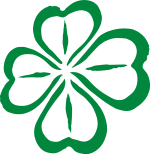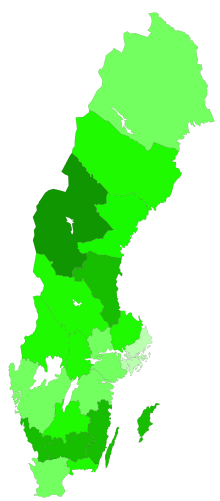
A | B | C | D | E | F | G | H | CH | I | J | K | L | M | N | O | P | Q | R | S | T | U | V | W | X | Y | Z | 0 | 1 | 2 | 3 | 4 | 5 | 6 | 7 | 8 | 9
Centre Party Centerpartiet | |
|---|---|
 | |
| Abbreviation | C |
| Party Chairman | Muharrem Demirok |
| Leader in the Riksdag | Daniel Bäckström[1] |
| Party Secretary | Karin Ernlund[2] |
| Founded | 2 March 1913 |
| Headquarters | Stora Nygatan 4, Gamla stan, Stockholm |
| Youth wing | Centre Party Youth |
| Membership (2020) | |
| Ideology | Liberalism (Swedish) Agrarianism (Nordic) |
| Political position | Centre to centre-right |
| European affiliation | Alliance of Liberals and Democrats for Europe Party |
| International affiliation | Liberal International |
| European Parliament group | Renew Europe |
| Nordic affiliation | Centre Group |
| Colours | Green |
| Riksdag[4] | 24 / 349 |
| European Parliament[5] | 2 / 21 |
| County councils[6] | 155 / 1,696 |
| Municipal councils[7] | 1,603 / 12,700 |
| Website | |
| centerpartiet | |
The Centre Party (Swedish: Centerpartiet [ˈsɛ̂nːtɛrpaˌʈiːɛt] , C) is a liberal[8][9][10] political party in Sweden, founded in 1913.
The party focuses on the national economy, the environment, political decentralisation and social integration. It is represented in all of the Riksdag's parliamentary committees, currently holding 24 seats. From 2019 to 2021, it provided confidence and supply to the Löfven II cabinet.
Traditionally part of the Nordic agrarian family of political parties, the Centre Party has increasingly switched focus towards economic liberalism, environmental protection, equality of the sexes and decentralisation of governmental authority.[11][12] The party describes itself as liberal feminist,[13] campaigning for policies which enhance gender equality on an individualist basis. Its environmental policies stress the importance of consent and voluntary action,[14] including working with foresters and private landowners to promote biodiversity within a mutually agreeable framework.[15]
The Centre Party has produced two prime ministers of Sweden, who served a total of three terms; Thorbjörn Fälldin was the last Centre Party prime minister, and held the post for a total of five years, from 1976 to 1978 and then again from 1979 to 1982. It is a member of the Alliance of Liberals and Democrats for Europe, the Liberal International and Renew Europe. It was originally named the Farmers' League (Swedish: Bondeförbundet [ˈbʊ̂nːdɛfœrˌbɵndɛt] ; B).
History
This section needs to be updated. (October 2022) |

The party was founded in 1913 as the Farmers' League (Swedish: Bondeförbundet, B). In 1922, it merged with the National Farmers' Union (Swedish: Jordbrukarnas Riksförbund [ˈjûːɖˌbrʉːkaɳas ˈrɪ̂ksfœrˌbɵnd] , JR), and adopted its current name in 1957. At that time, it had been the closest ally of the centre-left Swedish Social Democratic Party (SAP) for twenty-five years, and one of the SAP’s coalition partners between 1936 and 1945 as well as between 1951 and 1957. However, it later revised this strategy in order to establish a closer long-term alliance between the centre-right borgerlig ("bourgeois" or "nonsocialist") parties that achieved power between 1976 and 1982 and between 1991 and 1994.
Thorbjörn Fälldin served as Leader of the Centre Party and Prime Minister of Sweden from 1976 until 1982, except for a short interregnum between 1978 and 1979 led by Liberal People's Party leader Ola Ullsten. The Centre Party joined another centre-right government following the 1991 general election, led by Moderate Party leader Carl Bildt. During the leaderships of Maud Olofsson and Annie Lööf in the 2000s, the party positioned itself clearly on the political right as a small-business-friendly party, advocating market liberal policies and viewing the Social Democrats as its main opponent.[16][11][17]
In 2005, the Centre Party the newspaper group it owned, Centertidningar AB, for 1.8 billion SEK,[18] which made it the richest political party in the world at the time.[19] In 2022, Annie Lööf resigned her position as Leader of the Centre Party.
2006 general election

The 2006 Swedish general election was a success for the Centre Party. Its support had been slowly increasing through recent elections, receiving 5.1% of the votes in 1998 and increasing this to 6.2% in 2002.[20] In the 2006 Swedish general election, 7.88% of the vote went to the Centre Party, entitling the party to 29 of the 349 seats in the Riksdag.[21] Furthermore, their alliance with the other parties in the Alliance for Sweden, a centre-right coalition which won a majority of parliament seats in this election, meant that the Centre Party shared the ministry posts with their Alliance for Sweden allies, namely the Moderate Party, the Liberal People's Party and the Christian Democrats. The strong victory by the Centre Party has been studied by political scientist Lina M. Eriksson, who in her dissertation from the Department of Government at Uppsala University, entitled "Natural Disasters and National Election", performs a rigorous statistical analysis of election data combined with interviews with Maud Olofsson, Eskil Erlandsson, Ulrica Messing and Mona Sahlin. Eriksson's research finds that both the Indian Ocean's 2004 Boxing Day Tsunami and the 2005 Cyclone Gudrun (Erwin) which struck only two weeks following the tsunami are major events that impacted government popularity in the general election and contributed to the redistribution of voter support within and across party-blocs, with particularly interesting results for the Centre Party. According to this research, "he core findings from this thesis show that the Swedish Social Democratic Party (S) government's poor crisis response to Gudrun, which is the hitherto most costly natural disaster in Swedish history, alone has an estimated effect of a magnitude that likely contributed to the 2006 historic regime shift, while the tsunami also seems to have mattered. The tsunami is particularly interesting, as S's poor international crisis response to the event constitutes the first natural disaster situation to knowingly have affected an election on the other side of the planet. Moreover, to some degree voters recognized the active opposition by C as effective representation and rewarded the party for its strong stance on the poor handling of both events by S. In fact, the active voice of C concerning these disasters likely helped move the party from the periphery of party politics to becoming the third-largest party in Swedish politics".[22] Part of the dissertation has been published in Electoral Studies which is to be considered the leading scientific journal in election research. In the article,[23] long-term effects are also found over the 2010 and 2014 Swedish general elections, implying that the Cyclone Gudrun in particular triggered long-lasting changes in voter support from the left to the right side of the political spectrum. A comprehensive summary of the dissertation is available for download via Uppsala University.[24]
Ideology and political position
The Centre Party sits on the centre[25] to centre-right[26][27][28] of the political spectrum. The party has also described as social liberal,[29] economically liberal,[30] and "ecological-liberal".[31] It describes itself as a green-liberal and libertarian party,[32][33] while it has been traditionally associated with agrarianism and the Nordic agrarian party family.[34][35][36]
National economy
The party has been described as one of Sweden's most market liberal parties in liberal, socialist and conservative media.[37] It describes itself as "a party with a green, social and decentralised liberalism".[38] The party advocates lower taxes, greatly reduced employer contributions, a freer market and an increased RUT-deduction. The party is a major supporter of the interests of small businesses, farmers and entrepreneurs.[39] It also favours investments in infrastructure and transportation, to allow employees to work in bigger cities but still live in the rural areas and vice versa. On economic policy, it views the Social Democrats and the Sweden Democrats as its opponents, though it supported a government led by the Social Democrats till 2022.
Immigration
The party is liberal on immigration, seeking to combine a generous immigration policy with an initially more restrictive contribution policy to the immigrants. After the European migrant crisis, the party proposed to replace the existing establishment grants with establishment loans, similar to the Swedish student loans.[40]
The balance of the state responsibility of accepting refugees with their responsibility for integration into Swedish society is at the core of the party policy. In January 2016, the party for example proposed to give all immigrants compulsory civic education in both rights and expectations from the society.[41]
European Union
The party is a decentralist pro-European party that considers the European Union important for the preservation of peace, freedom and trade in Europe. The party also advocates a smaller but sharper European Union focused on promoting democracy, peace, free movement, free trade, vigorous action against climate change and collaboration against organized crime, while also believing that Sweden should stay outside the Economic and Monetary Union of the European Union and keep the krona as its currency.[42]
The party is a member of the ALDE Party and its affiliated European Parliament group Renew Europe.[43] In the European Committee of the Regions, the Centre Party sits with the Renew Europe CoR group with one full and one alternate member for the 2020-2025 mandate.[44][45]
Publications
The Centre Party owned a media consortium called Centertidningar AB. It included newspapers that the party had either started on their own or brought from competitors. It included Hallands Nyheter, Södermanlands Nyheter, Länstidningen i Södertälje, Nynäshamns Posten, Norrtelje Tidning, Lidingö Tidning, Ljusdalsposten, Östersunds-Posten, Hälsingekuriren and Hudiksvalls Tidning. The consortium was split in 2005 and sold to Mittmedia, Stampen Group and VLT for a total of 1.815 billion Swedish kronor.
Electoral results

Riksdag
| Election | Votes | % | Seats | +/– | Government |
|---|---|---|---|---|---|
| Sep 1914 |
1,507 | 0.2 (#4) | 0 / 230
|
Extra-parliamentary | |
| 1917 | 39,262 | 5.3 (#5) | 9 / 230
|
Opposition | |
| 1920 | 52,318 | 7.9 (#4) | 20 / 230
|
Opposition | |
| 1921 | 192,269 | 11.0 (#4) | 21 / 230
|
Opposition | |
| 1924 | 190,396 | 10.8 (#4) | 23 / 230
|
Opposition | |
| 1928 | 263,501 | 11.2 (#4) | 27 / 230
|
Opposition | |
| 1932 | 321,215 | 14.1 (#3) | 36 / 230
|
Opposition (1932–1936) | |
| Minority (1936) | |||||
| 1936 | 418,840 | 14.4 (#3) | 36 / 230
|
Coalition | |
| 1940 | 344,345 | 12.0 (#3) | 28 / 230
|
Coalition | |
| 1944 | 421,094 | 13.6 (#3) | 35 / 230
|
Coalition (1944–1945) | |
| Opposition (1945–1948) | |||||
| 1948 | 480,421 | 12.4 (#3) | 30 / 230
|
Opposition | |
| 1952 | 406,183 | 10.7 (#4) | 26 / 230
|
Coalition | |
| 1956 | 366,612 | 9.5 (#4) | 19 / 231
|
Coalition | |
| 1958 | 486,760 | 12.7 (#4) | 32 / 231
|
Opposition | |
| 1960 | 579,007 | 13.6 (#4) | 34 / 232
|
Opposition | |
| 1964 | 559,632 | 13.2 (#4) | 36 / 233
|
Opposition | |
| 1968 | 757,215 | 15.7 (#2) | 39 / 233
|
Opposition | |
| 1970 | 991,208 | 19.9 (#2) | 71 / 350
|
Opposition | |
| 1973 | 1,295,246 | 25.1 (#2) | 90 / 350
|
Opposition | |
| 1976 | 1,309,669 | 24.1 (#2) | 86 / 349
|
Coalition (1976–1978) | |
| Opposition (1978–1979) | |||||
| 1979 | 984,589 | 18.1 (#3) | 64 / 349
|
Coalition | |
| 1982 | 859,618 | 15.5 (#3) | 56 / 349
|
Opposition | |
| 1985 | 490,999 | 8.8 (#4) | 43 / 349
|
Opposition | |
| 1988 | 607,240 | 11.3 (#4) | 42 / 349
|
Opposition | |
| 1991 | 465,356 | 8.5 (#4) | 31 / 349
|
Coalition | |
| 1994 | 425,153 | 7.7 (#3) | 27 / 349
|
Opposition | |
| 1998 | 269,762 | 5.1 (#5) | 18 / 349
|
Opposition | |
| 2002 | 328,428 | 6.2 (#6) | 22 / 349
|
Opposition | |
| 2006 | 437,389 | 7.9 (#3) | 29 / 349
|
Coalition | |
| 2010 | 390,804 | 6.6 (#5) | 23 / 349
|
Coalition | |
| 2014 | 370,834 | 6.1 (#5) | 22 / 349
|
Opposition | |
| 2018 | 557,500 | 8.6 (#4) | 31 / 349
|
External support | |
| 2022 | 434,945 | 6.7 (#5) | 24 / 349
|
Opposition |
European Parliament
| Election | Votes | % | Seats | +/– |
|---|---|---|---|---|
| 1995 | 192,077 | 7.2 (#5) | 2 / 22
|
|
| 1999 | 151,442 | 6.0 (#7) | 1 / 22
|
|
| 2004 | 157,258 | 6.3 (#6) | 1 / 19
|
|
| 2009 | 173,414 | 5.5 (#7) | 1 / 18 1 / 20
|
|
| 2014 | 241,101 | 6.5 (#6) | 1 / 20
|
|
| 2019 | 447,641 | 10.8 (#5) | 2 / 20
|
Voter base

Traditionally, most of the party's voters come from rural areas and include farmers and agricultural producers. Since the takeover of Maud Olofsson in recent years, the party has been attracting liberal voters from urban areas in central Sweden. It is believed that voters from the Liberals have been moving to the Centre Party due to changes in both parties.[46]
Leaders of the Centre Party
The Leader of the Centre Party is its highest political and organisational officer, its president in the National Executive Board and representative of the party in the media, in public and with other parties.[47] The party leader has often held an important cabinet portfolio when the party has been part of a coalition.

